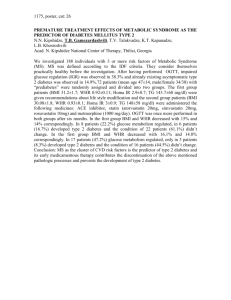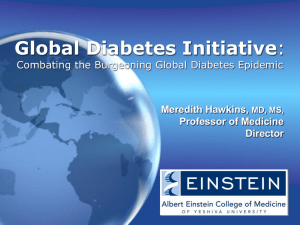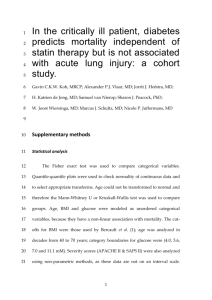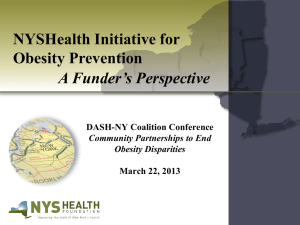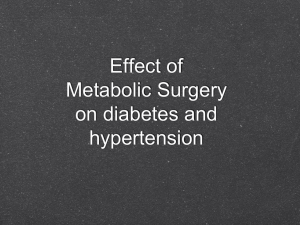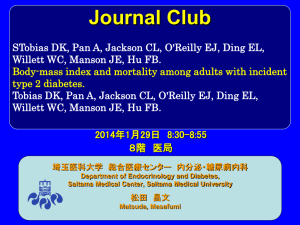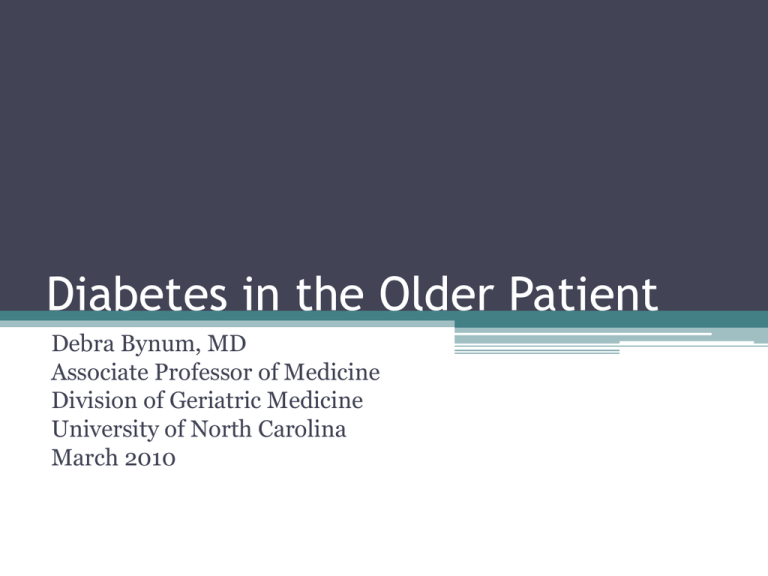
Diabetes in the Older Patient
Debra Bynum, MD
Associate Professor of Medicine
Division of Geriatric Medicine
University of North Carolina
March 2010
True or False?
• 1. A healthy 90 year old woman is likely to live to
be 95…
• 2. Obesity is associated with increased mortality
in people over the age of 70
• 3. Patients over the age of 80 with systolic
hypertension should not be treated because of an
increased risk of falls
Outline
•
•
•
•
•
•
•
•
Prevalence
Heterogeneity (Patients and Disease)
Specific complications
Diabetes and Geriatric Syndromes
Diabetes in the Frail
Obesity in the Older Patient
Treatment Basics
Take Home Points
Focus
• How is diabetes different in the older patient?
Prevalence
• Majority of patients with DM are over age 60
• >10% patients over age 65 have DM
• >10% over age 60 may have undiagnosed DM
• CDC estimates prevalence of DM: 23% (diagnosed
and undiagnosed) in people over 60
• Framingham Data: 40% those over 65 have DM or
Impaired Fasting Glucose
Heterogeneity: Patients
• Average Life expectancy 72-79
▫ At age 65, average life expectancy 82
▫ At age 85, average life expectancy 90
▫ Fastest growing population: over 85
• Differences
▫ Age (65, 75, 85, 95, 100)
▫ Frailty and age are not equal
▫ Associated co-morbidities
Heterogeneity: Disease
• Patients with long standing Type 2 Diabetes associated
with family history, obesity, and metabolic syndrome
• Latent Autoimmune Diabetes in Adults (LADA)
• Patients with long standing Type 2 DM with no family
history and normal BMI
• Patients with new diagnosis of DM after age 60
• Growing population of Patients over age 60 with
longstanding Type 1 Diabetes
LADA
• Autoimmune (antibodies present at diagnosis)
• Resembles type I diabetes
• Later onset (after age 30)
• Slower progression toward absolute insulin
requirement (presentation with ketosis
uncommon)
Complications
Hyperglycemia
• Dehydration
▫ Increased risk in elderly
▫ Decreased oral intake, decreased thirst
mechanism
• Visual disturbance
• Confusion
Nonketotic Hyperglycemic
Hyperosmolar Coma
• Extremely high glucose in setting of extreme dehydration
• Often associated with infection, myocardial event, stroke
• More common than DKA in older adults
• Higher mortality
• Older patients with dementia, decreased access to free
water (nursing care setting), and decreased thirst are at
higher risk
Hypoglycemia
• Risk Factors:
▫
▫
▫
▫
▫
▫
▫
▫
Older age
Renal insufficiency
Long acting oral agents (sulfonylureas)
Poor nutrition
Alcohol use
CHF
Post hospitalization/ frequent hospitalizations
Polypharmacy
Hypoglycemia
• Risk 2-9% in cohort studies
• ?association with later development of dementia
▫ Cohort study of patients followed over 20 years
▫ Patients with at least one episode of severe
hypoglycemia had increased risk of development
of diabetes
▫ May be confounder and not causal…
JAMA 2009
Nephropathy
• Overall increase prevalence of Renal Insufficiency
and ESRD in older patients
• Older patients may have multiple etiologies for renal
failure (DM, HTN, medications)
• Microalbuminuria common (over 30%) and not as
predictive of future ESRD in older patients
▫ Highly predictive of CV and stroke risk
• ACE inhibitors still recommended
Renal Insufficiency
• “Normal Creatinine” may not be normal
▫ Calculate GFR
▫ GFR depends upon age, weight, sex
▫ Creatinine of 1.1 in an 80 pound woman who
weighs 98 pounds is not “normal”
Visual Loss
• Often multifactorial
• Retinopathy often less progressive than in
younger patients with DM
• Glaucoma three times more common in older
patients with DM (11% vs 4%)
• Cataracts more common and more rapidly
progressive
Foot Care
• Neuropathy
▫ Common and not always due to DM in older
patients (50% patients over 80 have peripheral
neuropathy)
▫ 1/3 older patients cannot see/reach feet
Foot Care
• Elderly with DM high risk for infection,
cellulitis, ulcers, gangrene and amputation
• Cohort study of patients over 10 years, average
age 75, from Archives Int Med, 2007:
▫ 19% DM group had episode of gangrene
▫ 3% DM group had amputation
Cardiovascular Risk
• Challenges:
▫ Most older patients with DM will die of CV disease
▫ Treatment-Risk Paradox
Older patients have high risk of CV disease
Even small potential decrease in risk of disease could
have big benefit and be work risk of treatment
▫ No evidence to suggest that control of diabetes
results in less CV risk
CV Disease: Modification of Risk
Factors
• Evidence that older patients with DM and CVD
and hyperlipidemia benefit from treatment with
statins (similar to/better than younger
population)
• Recent studies also showing no additional
benefit to “tight” control
CV Disease: Modification of Risk
Factors
• Evidence from multiple large studies (SHEP,
Syst-Eur) that older patients with Systolic
Hypertension benefit from treatment
▫ Decrease stroke
▫ Decrease CHF
• HYVET:
▫ Patients over age 80 benefit with decrease stroke,
CHF, and mortality
Hypertension in Older Patients
• Keys from studies:
▫
▫
▫
▫
Treated Systolic Hypertension
Target SBP 150
Followed standing blood pressures
Benefit seen even though significant number of
patients did not even reach target SBP of 150
▫ Take Home: Moderate SBP reduction in
the very elderly can have significant
benefit!
Complications: Geriatric Syndromes
• Older patients with DM also more likely to have:
▫
▫
▫
▫
▫
▫
Falls
Sarcopenia/muscle wasting
Malnutrition
Depression
Dementia
Urinary Incontinence
Diabetes in the Frail
• More modest goals in BP and glucose control
• Balance quality if life
• Observe for other risks
▫ Ulcers (heel and sacral)
▫ Malnutrition
▫ dehydration
Obesity
• Modest overweight (BMI 25-30) associated with
LESS mortality in older people
• Likely association with increased mortality when
BMI over 30
• Conflicting studies with association between
weight loss and increased mortality
Obesity
• BMI does not perform well in older patients
(increased body fat for same weight as we age)
• Waist circumference has greater prognostic value
than BMI in older patients
• Weight loss can be associated with loss of muscle
and risk of malnutrition in older patients
• Almost impossible to tease apart possible
underlying disease and weight loss in patients over
age 70
Dietary Restrictions
• No evidence to suggest dietary restrictions in
frail elders
• Balance other concerns:
▫
▫
▫
▫
▫
▫
Quality of life
Malnutrition
Vitamin deficiencies (D)
Risk of fracture
Depression
Chewing/dental problems
Treatment
• Treatment options usually similar, balance comorbidities, frailty, and life expectancy
• Target systolic hypertension and hyperlipidemia
▫ No evidence to suggest “tight” control
▫ Modest treatment does have benefit at CV risk
reduction in older patients: do not avoid treatment
based upon age!!
• No evidence to suggest tight control of DM
▫ Goal Hgb A1C 7-8% suggested
▫ Recent ACCORD data supports this
Treatment
• Must take into account functional status and
caregiver/facility status
▫ Consideration of insulin and glucose monitoring
?caregiver help if needed
Vision
Arthritis of hands
Cognitive status
▫ Treatment in some cases easier in nursing care
facility
▫ Do not avoid treatment in functional, independent
patients or in those with needed support
Take Home Points
• Older patients with DM differ in many ways
• Treatment of DM relies upon treatment of the individual
• Do not avoid treatment in older patients based upon age
▫ Older patients with have higher risk of bad outcomes
▫ Modest treatment benefit significant the high risk
• Consider goals of treatment and balance: BP, glucose,
weight and lipid reduction goals should be MODEST
Questions and Discussion


